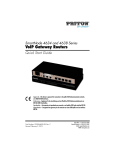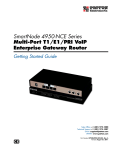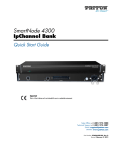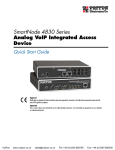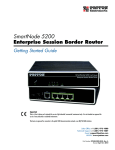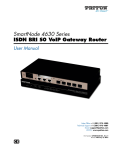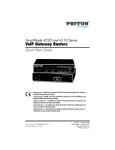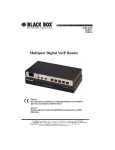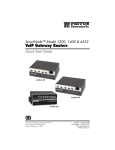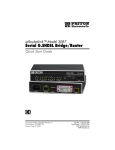Download Patton electronic SMARTNODE 4950 User's Manual
Transcript
SmartNode 4950 Series Multi-Port T1/E1/PRI VoIP Enterprise Gateway Router Quick Start Guide Part Number: 07MSN4950-QS, Rev. A Revised: June 7, 2011 Sales Office: +1 (301) 975-1000 Technical Support: +1 (301) 975-1007 E-mail: [email protected] WWW: www.patton.com WARNING • Do not open the device when the power cord is connected. For systems without a power switch and without an external power adapter, line voltages are present within the device when the power cord is connected. • For devices with an external power adapter, the power adapter shall be a listed Limited Power Source The mains outlet that is utilized to power the device shall be within 10 feet (3 meters) of the device, shall be easily accessible, and protected by a circuit breaker in compliance with local regulatory requirements. • For AC powered devices, ensure that the power cable used meets all applicable standards for the country in which it is to be installed. • For AC powered devices which have 3 conductor power plugs (L1, L2 & GND or Hot, Neutral & Safety/Protective Ground), the wall outlet (or socket) must have an earth ground. • For DC powered devices, ensure that the interconnecting cables are rated for proper voltage, current, anticipated temperature, flammability, and mechanical serviceability. • WAN, LAN & PSTN ports (connections) may have hazardous voltages present regardless of whether the device is powered ON or OFF. PSTN relates to interfaces such as telephone lines, FXS, FXO, DSL, xDSL, T1, E1, ISDN, Voice, etc. These are known as “hazardous network voltages” and to avoid electric shock use caution when working near these ports. When disconnecting cables for these ports, detach the far end connection first. • Do not work on the device or connect or disconnect cables during periods of lightning activity. In accordance with the requirements of council directive 2002/96/EC on Waste of Electrical and Electronic Equipment (WEEE), ensure that at endof-life you separate this product from other waste and scrap and deliver to the WEEE collection system in your country for recycling. This device contains no user serviceable parts. This device can only be repaired by qualified service personnel. WARNING 2 SmartNode 4950 Series Quick Start Guide CAUTION Electrostatic Discharge (ESD) can damage equipment and impair electrical circuitry. It occurs when electronic printed circuit cards are improperly handled and can result in complete or intermittent failures. Do the following to prevent ESD: • Always follow ESD prevention procedures when removing and replacing cards. • Wear an ESD-preventive wrist strap, ensuring that it makes good skin contact. Connect the clip to an unpainted surface of the chassis frame to safely channel unwanted ESD voltages to ground. • To properly guard against ESD damage and shocks, the wrist strap and cord must operate effectively. If no wrist strap is available, ground yourself by touching the metal part of the chassis. 1.0 Power up the SmartNode 1. Insert the barrel type connector end of the AC power cord into the external power supply connector. 2. Insert the female end of the power cord into the internal power supply connector. 3. Verify that the AC power cord included with your router is compatible with local standards. If it is not, contact Patton to replace it with a compatible power cord. 4. Connect the male end of the power cord to an appropriate power outlet. 5. Wait until the Power LED stops blinking and remains constantly lit. Now the SmartNode is ready to configure. 2.0 Connecting the SmartNode to your laptop PC The interconnecting cables shall be acceptable for external use and shall be rated for the proper application with respect to voltage, current, anticipated temperature, flammability, and mechanical serviceability. CAUTION SmartNode 4950 Series Quick Start Guide 3 0/3 0/2 0/1 T1 /E1 0/0 ET H 0/1 H 0/0 Reset ET Co ns RS ole -23 2 LAN (connect to ETH 0/1) Ethernet Laptop PC Figure 1. Connecting to the PC 1. Connect the PC’s Ethernet port to LAN (ETH 0/1) port of the SmartNode 4950. The SmartNode 4950 Series is equipped with Auto-MDX Ethernet ports, so you can use straight-through or cross-over Ethernet cables for host or hub/switch connections. (See figure 1.) 2. The SmartNode comes with a built-in DHCP server to simplify configuration. Therefore, to automatically configure the PC for IP connectivity to the SmartNode, configure the laptop PC for DHCP. The SmartNode will provide the PC with an IP address. Note that only Full Duplex operation is supported. Use auto negotiation for best results. 3. Check the connection to the SmartNode by executing the ping command from the PC command window as follows: ping 192.168.1.1 3.0 Configuring the desired IP address 3.1 Factory-default IP settings The factory default configuration for the Ethernet interface IP addresses and netmasks are listed in table 1. Both Ethernet interfaces are activated upon power-up. LAN interface ETH 0/1 (LAN) provides a default DHCP server. The WAN interface uses DHCP client to get the IP address and netmask automatically from the service provider. Table 1. Factory default IP address and network mask configuration Item IP Addresss Network Mask WAN interface Ethernet 0 (ETH 0/0) DHCP DHCP LAN interface Ethernet 1 (ETH 0/1) 192.168.1.1 255.255.255.0 DHCP server address range (LAN) 192.168.1.10-192.168.1.99 255.255.255.0 If these addresses match with those of your network, go to section 4.0 “Connecting the SmartNode to the network” on page 5. Otherwise, continue with the following sections to change the addresses and network masks. 4 SmartNode 4950 Series Quick Start Guide 3.2 Login 1. To access the SmartNode, start the Telnet application on your PC. Type the default IP address into the address field: 192.168.1.1. Accessing your SmartNode via a Telnet session displays the login screen. Type the factory default login: administrator and leave the password empty. Press the Enter key after the password prompt. login:administrator password:<Enter> 192.168.1.1> 2. After you log in, your SmartNode will be running in operator execution mode (indicated by > character in the command line prompt). To enter configuration mode, use the commands enable and configure. 192.168.1.1>enable 192.168.1.1#configure 192.168.1.1(cfg)# 3.3 Changing the WAN IP address 1. To modify IP configuration settings, you must enter context IP mode. Enter the following command: 192.168.1.1(cfg)#context ip router 192.168.1.1(ctx-ip)[router]# 2. Now you can set your IP address and network mask for the interface ETH 0/0(WAN). In this example a network 172.16.1.0/24 is assumed. The IP address in example is set to 172.16.1.99. (You should set it to the IP address that the network provider has given you.) Note The examples in this guide use a private IP network with the network address 172.16.1.0/24. 192.168.1.1(ctx-ip)[router]#interface WAN 192.168.1.1(if-ip)[WAN]#ipaddress 172.16.1.99 255.255.255.0 2002-10-29T00:09:40 : LOGINFO : Link down on interface WAN. 2002-10-29T00:09:40 : LOGINFO : Link up on interface WAN. 172.16.1.99(if-ip)[WAN]# 3. Copy this modified configuration to your new start-up configuration. This will store your changes in nonvolatile memory. On the next start-up the system will initialize itself using the modified configuration. 172.16.1.99 (if-ip)[WAN]#copy running-config startup-config 172.16.1.99 (if-ip)[WAN]# The SmartNode can now be connected to your network. 4.0 Connecting the SmartNode to the network The interconnecting cables shall be acceptable for external use and shall be rated for the proper application with respect to voltage, current, anticipated temperature, flammability, and mechanical serviceability. CAUTION SmartNode 4950 Series Quick Start Guide 5 In general, the SmartNode will connect to the network via the WAN (ETH 0/0) port. This enables the SmartNode to offer routing services to the PC hosts on LAN (ETH 0/1) port. The SmartNode 4950 Series provides an autoMDX feature for both Ethernet ports, so you can use a straight-through or cross-over cable to connect to a host or a switch (see figure 2). 0/3 0/2 0/1 T1 /E 1 0/0 ET H 0/1 0/0 Reset ET H LAN Co ns ole RS -2 32 LAN (ETH 0/1) WAN (ETH 0/0) Straight-through wired or crossover cable Network Figure 2. Connecting the SmartNode to the network 1. You can check the connection with the ping command from the SmartNode to another host on the local LAN. 172.16.1.99(if-ip)[WAN]#ping <IP Address of the host> Note If the WAN address is not set to DHCP, to ping a device outside your local LAN you must first configure the default gateway. (For information on configuring the default gateway, refer to section “Set IP addresses” in Appendix C, “Command Summary” of the SmartNode Series SmartWare Software Configuration Guide.) 5.0 Loading the configuration (optional) Patton provides a collection of configuration templates on the CD-ROM shipped with your SmartNode device— and also on the support page at www.patton.com/voip—one of which may be similar enough to your application that you can use it to speed up configuring the SmartNode. Simply download the configuration note that matches your application to your PC. Adapt the configuration as described in the configuration note to your network (remember to modify the IP address) and copy the modified configuration to a TFTP server. The SmartNode can now load its configuration from this server. Note Patton regularly adds new configuration templates to the collection at www.patton.com/voip, so if you do not see your application on the CD-ROM, it may have been added to the website. Note If your application is unique and not covered by any of Patton’s configuration templates, you can manually configure the SmartNode instead of loading a configuration file template. In that case, refer to the 6 SmartNode 4950 Series Quick Start Guide SmartNode Series SmartWare Software Configuration Guide for information on configuring the SmartNode device. In this example we assume an TFTP server resides on the host with the IP address 172.16.1.11 and the configuration file named SN.cfg resides in the root directory of the TFTP server. 172.16.1.99(if-ip)[WAN]#copy tftp://172.16.1.11/SN.cfg startupconfig Download...100% 172.16.1.99(if-ip)[WAN]# After you reboot the SmartNode the new startup configuration will become active. IMPORTANT When you issue the reload command, the SmartNode will ask if you want to copy the running configuration to the startup configuration. Since you just downloaded a configuration file to the startup configuration you must answer this question with NO. Otherwise, the downloaded configuration will be overwritten and lost! 172.16.1.99(if-ip)[WAN]#reload Running configuration has been changed. Do you want to copy the 'running-config' to the 'startup-config'? Press 'yes' to store, 'no' to drop changes : no Press 'yes' to restart, 'no' to cancel : yes The system is going down 6.0 Additional Information Refer to the SmartNode Series SmartWare Software Configuration Guide and the SmartNode Getting Started Guide located on the CD-ROM shipped with your SmartNode device and available online at www.patton.com/ manuals. For detailed information about: • Installing, configuring, operating, and troubleshooting. • Warranty, trademark & compliance The CD-ROM also includes many freeware and shareware tools, including TFTP servers, and Telnet clients. SmartNode 4950 Series Quick Start Guide 7 A.0 Customer and Technical Support Toll-Free VoIP support: call sip:[email protected] with a VoIP SIP client Online support: www.patton.com E-mail support: [email protected]—answered within 1 business day Telephone support: • Standard: +1 (301) 975-1007 (USA), Monday–Friday: 8:00 am to 5:00 pm EST (1300 to 2200 UTC/GMT) • Alternate: +41 (0)31 985 25 55 (Switzerland), Monday–Friday: 8:00 am to 5:00 pm CET (0900 to 1800 UTC/GMT) Fax: +1 (253) 663-5693 (USA) or +41 (0)31 985 25 26 (Switzerland) B.0 Compliance Information B.1 Compliance EMC Compliance: • FCC Part 15, Class A • EN55022, Class A • EN55024 Safety Compliance: • UL60950-1/CSA C22.2 No. 60950-1 • IEC/EN 60950-1 • AS/NZS 60950-1 PSTN Regulatory Compliance: • FCC Part 68 • CS-03 • TBR 12 & 13 (E1) • AS/ACIF S016 • AS/ACIF S038 • AS/ACIF S043 (G.SHDSL card) • NZ ISDN Layer 3 Supplement 8 SmartNode 4950 Series Quick Start Guide B.2 Radio and TV interference The SmartNode router generates and uses radio frequency energy, and if not installed and used properly—that is, in strict accordance with the manufacturer’s instructions—may cause interference to radio and television reception. The SmartNode router have been tested and found to comply with the limits for a Class A computing device in accordance with specifications in Subpart B of Part 15 of FCC rules, which are designed to provide reasonable protection from such interference in a commercial installation. However, there is no guarantee that interference will not occur in a particular installation. If the SmartNode router does cause interference to radio or television reception, which can be determined by disconnecting the unit, the user is encouraged to try to correct the interference by one or more of the following measures: moving the computing equipment away from the receiver, re-orienting the receiving antenna and/or plugging the receiving equipment into a different AC outlet (such that the computing equipment and receiver are on different branches). B.3 FCC Part 68 (ACTA) Statement This equipment complies with Part 68 of FCC rules and the requirements adopted by ACTA. On the bottom side of this equipment is a label that contains—among other information—a product identifier in the format US: AAAEQ##TXXXX. If requested, this number must be provided to the telephone company. The method used to connect this equipment to the premises wiring and telephone network must comply with the applicable FCC Part 68 rules and requirements adopted by the ACTA. If this equipment causes harm to the telephone network, the telephone company will notify you in advance that temporary discontinuance of service may be required. But if advance notice isn’t practical, the telephone company will notify the customer as soon as possible. Also, you will be advised of your right to file a complaint with the FCC if you believe it is necessary. The telephone company may make changes in its facilities, equipment, operations or procedures that could affect the operation of the equipment. If this happens the telephone company will provide advance notice in order for you to make necessary modifications to maintain uninterrupted service. If trouble is experienced with this equipment, for repair or warranty information, please contact our company. If the equipment is causing harm to the telephone network, the telephone company may request that you disconnect the equipment until the problem is resolved. Connection to party line service is subject to state tariffs. Contact the state public utility commission, public service commission or corporation commission for information. B.4 Industry Canada Notice This equipment meets the applicable Industry Canada Terminal Equipment Technical Specifications. This is confirmed by the registration number. The abbreviation, IC, before the registration number signifies that registration was performed based on a Declaration of Conformity indicating that Industry Canada technical specifications were met. It does not imply that Industry Canada approved the equipment. This Declaration of Conformity means that the equipment meets certain telecommunications network protective, operational and safety requirements. The Department does not guarantee the equipment will operate to the user's satisfaction. Before installing this equipment, users should ensure that it is permissible to be connected to the facilities of the local telecommunications company. The equipment must also be installed using an acceptable method of connection. In some cases, the company’s inside wiring associated with a single line individual service may be extended by means of a certified connector assembly (telephone extension cord). The customer should be aware that compliance with the above condition may not prevent degradation of service in some situations. SmartNode 4950 Series Quick Start Guide 9 Repairs to some certified equipment should be made by an authorized maintenance facility designated by the supplier. Any repairs or alterations made by the user to this equipment, or equipment malfunctions, may give the telecommunications company cause to request the user to disconnect the equipment. Users should ensure for their own protection that the ground connections of the power utility, telephone lines and internal metallic water pipe system, are connected together. This protection may be particularly important in rural areas. B.5 EC Declaration of Conformity (See section B.6 “EG-Konformitätserklärung” for German version.) Product Description: SmartNode 4950 Series This equipment conforms to the requirements of Council Directive 1999/5/EC on the approximation of the laws of the member states relating to Radio and Telecommunication Terminal Equipment and the mutual recognition of their conformity. The safety advice in the documentation accompanying the products shall be obeyed. The conformity to the above directive is indicated by the CE sign on the device. The signed Declaration of Conformity can be downloaded from www.patton.com/certifications/. B.6 EG-Konformitätserklärung (see section B.5 “EC Declaration of Conformity” for English version) Produktbezeichnung: SmartNode 4950 Baureihe Die bezeichneten Produkte stimmen in der von uns in Verkehr gebrachten Ausführung mit den Vorschriften folgender Richtlinie überein: R&TTE 1999/5/EG Richtlinie des europäischen Parlaments und des Rates zur Angleichung der Rechtsvorschriften der Mitgliedstaaten über Funkanlagen und Telekommunikations-Endeinrichtungen und die gegenseitige Anerkennung ihrer Konformität. Die Sicherheitshinweise in der mitgelieferten Produktdokumentation sind zu beachten. Die Konformität mit der oben erwähnten Richtlinie wird durch das CE-Zeichen auf dem Gerät bestätigt. Die unterzeichnete Konformitätserklärung kann heruntergeladen werden von: www.patton.com/ certifications/. 10 SmartNode 4950 Series Quick Start Guide Copyright statement Copyright © 2011, Patton Electronics Company. All rights reserved. The information in this document is subject to change without notice. Patton Electronics assumes no liability for errors that may appear in this document. Trademarks statement The term SmartNode is a trademark of Patton Electronics Company. All other trademarks presented in this document are the property of their respective owners. Warranty, Trademark, & Compliance Information For warranty, trademark and compliance information, refer to the Models SN4950 Series Getting Started Guide located on the CD-ROM that came with your VoIP Gateway Router or available online at www.patton.com. SmartNode 4950 Series Quick Start Guide 11 Notes ____________________________________________________________________ ____________________________________________________________________ ____________________________________________________________________ ____________________________________________________________________ ____________________________________________________________________ ____________________________________________________________________ ____________________________________________________________________ ____________________________________________________________________ ____________________________________________________________________ ____________________________________________________________________ ____________________________________________________________________ ____________________________________________________________________ ____________________________________________________________________ ____________________________________________________________________ ____________________________________________________________________ ____________________________________________________________________ 12 SmartNode 4950 Series Quick Start Guide












